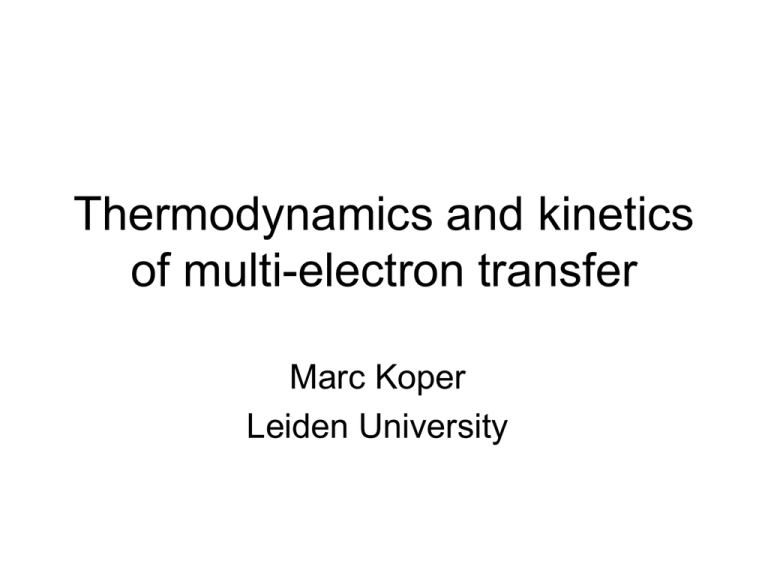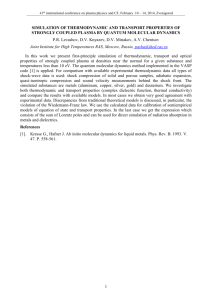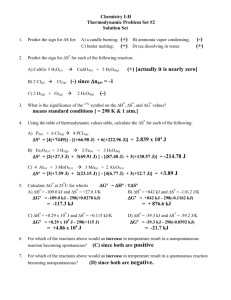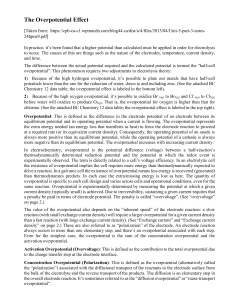Opportunities for theory in electrocatalysis
advertisement

Thermodynamics and kinetics of multi-electron transfer Marc Koper Leiden University Redox reactions of water current density H2 → 2 H+ + 2 eplatinum hydrogenase 2 H2O → O2 + 4 H+ + 4 ediffusionlimited current RuO2 PSII 1.23 0 diffusionlimited current 2 H+ + 2 e- → H2 PtNi laccase overpotential O2 + 4 H+ + 4 e- → 2 H2O E (vs.RHE) Catalysis of multi-step reactions Practically every (interesting) chemical reaction happens in a series of steps; catalysis is often about optimizing that sequence 1 e- / 1 step / 0 intermediate 2 e- / 2 steps / 1 intermediate >2 e- / >2 steps / >1 intermediate Single electron transfer • Marcus Theory • Activation energy determined by solvent reorganization energy λ (very difficult quantity to calculate accurately!) Movie of electron transfer Cl0 Cl- Cl0 + e- ClC.Hartnig, M.T.M.Koper, J.Am.Chem.Soc. 125 (2003) 9840 Nonlinear solvent reorganization Effective radius gets smaller with higher charge C.Hartnig, M.T.M.Koper, J.Chem.Phys. 115 (2001) 8540 Orientation of water depends on charge: strongest change in electrostriction from 0 to -1 What Marcus does not account for • Proton transfer • Bond making and bond breaking • Catalysis Two electron transfer 2 H+ + 2 e- H2 H+ + e- Hads (Volmer) Hads + H+ + e- H2 (Heyrovsky) free energy H+ + e- Hads H2 Thermodynamics 2 H+ + 2 e- H2 H+ + e- Hads Hads + H+ + e- H2 E0 = 0 V E10 = - ΔGads(H)/e0 E20 = ΔGads(H)/e0 Thermodynamic restriction: (E10 + E20)/2 = E0 Potential-determining step The potential-determining step is the step with the least favorable equilibrium potential The difference in the equilibrium potential of the potential-determining step and the overall equilibrium potential we will call the thermodynamic overpotential ηT Thermodynamic volcano plot zero thermodynamic overpotential descriptor R.Parsons,Trans.Faraday Soc. (1958); H.Gerischer (1958) M.T.M.Koper, H.A.Heering, in press J.K.Nørskov et al., J.Electrochem.Soc. (2004) M.T.M.Koper, E.Bouwman, Angew.Chem.Int.Ed. (2010) Generalization H+ + e- Hads plus 2 Hads H2 (e-chem) H+ + 2e- H- plus H- + H+ H2 (hydrogenase) The optimal electrocatalyst is achieved if each step is thermodynamically neutral. The H intermediate must bind to the catalyst with a bond strength equal to ½ E(H-H). What about activation barriers? • Can in principle be estimated with a more sophisticated model • Contribution of water is constant (to a first approximation) as we vary the catalyst • Activation barrier follows variations in the thermodynamics because of the BronstedEvans-Polanyi (BEP) relationship δEact = αδEreact “Marcus” model for HER/HOR • Combines a Hückel-type model for a diatomic molecule with a coupling to the metal electronic levels and a Marcus-type coupling to the solvent • Calculates approximate activation barriers E.Santos, M.T.M.Koper, W.Schmickler, Chem.Phys. 344 (2008) 195 Experimental volcano for H2 evolution J.Greeley, J.K.Nørskov, L.A.Kibler, A.M.El-Aziz, D.M.Kolb, ChemPhysChem 7 (2006) 1032 Good catalysts for HOR exist • Platinum • Hydrogenases (FeFe, FeNi) • They optimize for the binding of H*/Hads More than 2 electron transfers O2 + 4 H+ + 4 e- 2 H2O E0 = 1.23 V O2 + H+ + e- OOHads E10 OOHads + H+ + e- 2 OHads E20 2 OHads + 2 H+ + e- 2 H2O E30 Thermodynamic restriction: (E10 + E20 + 2 E30)/4 = E0 Lining up energy levels free energy O2 OOHads OHads H2O Thermodynamic overpotential now depends on the ability of the catalyst to bind oxygen Gold: weak oxygen binding Platinum: stronger oxygen binding Scaling relationships F.Abild-Petersen, J.Greeley, F.Studt, P.G.Moses, J.Rossmeisl, T.Munter, T.Bligaard, J.K. Nørskov, Phys.Rev.Lett. 99 (2007) 016105 Thermodynamic volcano plot Bad news : because of the scaling relationships, we cannot line up the E0’s. non-zero thermodynamic overpotential Experiment volcano plot ORR J.Greeley et al. Nature Chem. 1 (2009) 552 Pt3Ni and Fe-based catalyst V.Stamenkovic et al., Science (2007) M.Lefevre et al. Science (2009) ORR is a difficult case Man and nature have the same problem: Pt and laccase are good but not perfect catalysts for the ORR We need to beat the scaling relationships Fundamental problem with catalyzing reactions with more than 2 steps and more than 1 intermediate. Mechanism for OER O2 + 4 H+ + 4 e- 2 H2O E0 = 1.23 V H2O OHads + H+ + eOHads Oads + H+ + e2 Oads O2 Oads + H2O OOHads + H+ + eOOHads O2 + H+ + e- E 01 E02 Keq E 03 E 04 Volcano plot non-zero thermodynamic overpotential J.Rossmeisl et al. J.Electroanal.Chem (2007) Comparsion RuO2 and OEC Oads + H2O OOHads + H+ + ePDS on RuO2 (ηT=0.37 V) and on Loll et al. (ηT=0.32 V) OOHads O2 + H+ + e- PDS on Ferreira et al. (ηT=0.21 V) J.Rossmeisl, K.Dimitrevskii, P.Siegbahn, J.K.Norskov, J.Phys.Chem.C 111 (2007) 18821 Ni-doped RuO2 P.Krtil et al., Electrochim. Acta (2007) Why chlorine electrolysis works 2 Cl- Cl2 + 2 e- E0 =1.36 V ηT = 0 V 2 H2O O2 + 4 H+ + 4 e- E0 = 1.23 V ηT > 0 V Both are catalyzed by RuO2/TiO2 Chlorine electrolysis works thanks to the scaling relationships. Electrocatalytic CO2 reduction CO 2e- CO2 2e- high overpotential CH4, C2H4, CxHy Cu HCOOH difficult aldehyde Calvin cycle alcohol 2e- C2O42- fuel? Conclusions • Optimizing the binding of key intermediates is the key to a good catalyst • This is inherently more difficult for 2 or more intermediates than for 1 intermediate (scaling relationships) • DFT is a useful tool in understanding and screening catalysts • Can we efficiently and selectively reduce CO2 to something useful? Acknowledgments • Dirk Heering (Leiden) • Jan Rossmeisl, Jens Nørskov (Lyngby) • ELCAT Marie Curie Initial Training Network, http://www.elcat.org.gu.se/ • NWO, NRSC-C







